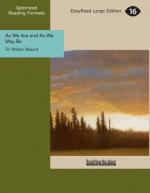It is, again, a great place for children. They are sent here just as they are sent to the British Museum and the South Kensington Museum, in order to be out of the way. You will always see children in these places, strolling listlessly among the rooms and corridors. Once, for instance, on a certain Easter Monday, I encountered, in the South Kensington Museum, a miserable little pair, who were crying in a corner by themselves. Beside the cases full of splendid embroideries and golden lace, among which they had strayed, they looked curiously incongruous, and somewhat like the unfortunate pair led to their destruction by the wicked uncle. They had, in fact, been sent to the museum by their mother, with a piece of bread-and-butter for their dinner, and told to stay there all day long. By this time the bread-and-butter had long since been eaten up, and they were hungry again, and there was a long afternoon before them. What to these hungry children would have been a whole Field of the Cloth of Gold? We must, therefore, make very large deductions indeed when we consider the popularity of Bethnal Green. Doubtless it is pleasant to read the stories of the pictures; but the light, the warmth, the society of the place are also pleasant. And as for Art education, why, as none is given, so none is desired.
I have dwelt upon Bethnal Green Museum at some length, not because I wished to attack the place, but because it seems to me an example of what ought not to be done, and because it illustrates most admirably two propositions which I have to offer. These are—(1) That the lower classes have no instinctive desire for Art; (2) that they will not teach themselves.
We may also learn from considering what this museum is what an educational and popular museum ought to be; and to this I will immediately return. Meantime, let us go on to consider a few minor agencies at work in the East of London, directly or indirectly working in favour of Art. And, first, I should like to call attention to the annual exhibition of pictures which the indefatigable Vicar of St. Jude’s, Whitechapel—the Rev. Samuel Barnett—gets together every Easter for his people. The point is not so much that he holds this exhibition as that he engages the services of volunteer lecturers, who go round the show with the visitors and explain the pictures, so that they may learn what it is they should admire and something of what they should look for in a drawing or painting. In other words, Mr. Barnett’s visitors are instructed in the first elements of Art criticism. There are, next, certain institutes, educational and social, such as the Bow and Bromley and the Beaumont, which might be used to advantage for Art purposes. Then there are the Church organizations, with their services, their clubs, their social, gatherings, and their schools; there are the chapels, each with its own set of similar institutions; there are the working men’s clubs, which might also lend themselves and their rooms for the development of Art; there are such societies as the Kyrle Society, which give free concerts of good music, and are therefore already working for us; lastly, there are the schools of Art—there are five in East London, working under the South Kensington Department. All these are agencies which either are already working in the interests of Art, or could be easily induced to do so.




